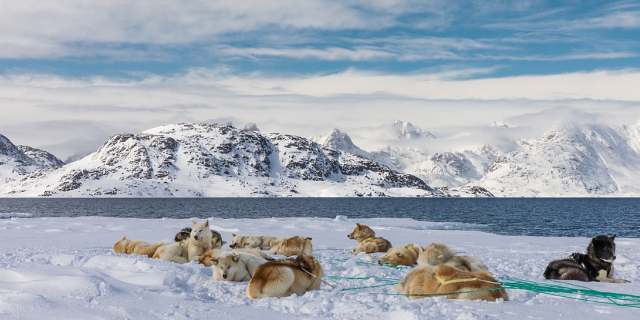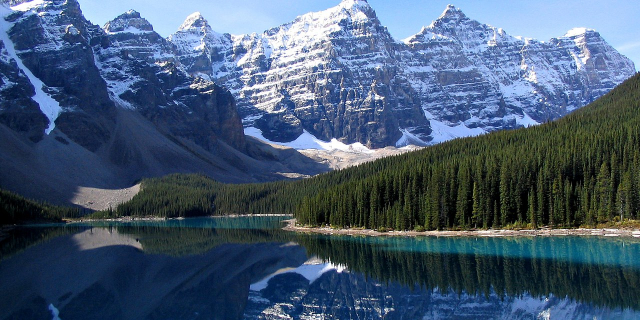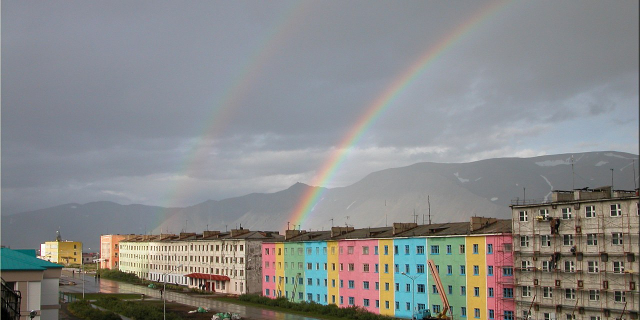Context of Nunavut
Nunavut ( NUU-nə-vuut, NOO-nə-voot; Inuktitut: ᓄᓇᕗᑦ [nunaˈvut], lit. 'our land'; French: [nunavut]) is the largest and northernmost territory of Canada. It was separated officially from the Northwest Territories on April 1, 1999, via the Nunavut Act and the Nunavut Land Claims Agreement Act, which provided this territory to the Inuit for independent government. The boundari...Read more
Nunavut ( NUU-nə-vuut, NOO-nə-voot; Inuktitut: ᓄᓇᕗᑦ [nunaˈvut], lit. 'our land'; French: [nunavut]) is the largest and northernmost territory of Canada. It was separated officially from the Northwest Territories on April 1, 1999, via the Nunavut Act and the Nunavut Land Claims Agreement Act, which provided this territory to the Inuit for independent government. The boundaries had been drawn in 1993. The creation of Nunavut resulted in the first major change to Canada's political map in half a century since the province of Newfoundland was admitted in 1949.
Nunavut comprises a major portion of Northern Canada and most of the Arctic Archipelago. Its vast territory makes it the fifth-largest country subdivision in the world, as well as North America's second-largest (after Greenland). The capital Iqaluit (formerly Frobisher Bay), on Baffin Island in the east, was chosen by a capital plebiscite in 1995. Other major communities include the regional centres of Rankin Inlet and Cambridge Bay.
Nunavut also includes Ellesmere Island to the far north, as well as the eastern and southern portions of Victoria Island in the west, and all islands in Hudson, James and Ungava bays, including Akimiski Island far to the southeast of the rest of the territory. It is Canada's only geo-political region that is not connected to the rest of North America by highway.
As of the 2021 Canadian census, Nunavut was the least populous of Canada's provinces and territories. One of the world's most remote, sparsely settled regions, Nunavut has a population of 39,589 (2021 figure, up from 35,944 in 2016), consisting mostly of Inuit. The population occupies a land area of just over 1,836,993.78 km2 (709,267.26 sq mi), or slightly smaller than Mexico (excluding water surface area). With a population density of 0.022/km2 (0.056/sq mi), Nunavut is the least densely populated country sub-division in the world, being even less densely populated than Denmark's Constituent Country of Greenland. Nunavut is also home to the world's northernmost permanently inhabited place, Alert. Eureka, a weather station on Ellesmere Island, has the lowest average annual temperature of any Canadian weather station.
More about Nunavut
- Population 36858
- Area 2038722
- Driving side right
- Early history
 Map showing Thule migration and Dorset decline
Map showing Thule migration and Dorset declineThe region which is now mainland Nunavut was first populated approximately 4,500 years ago by the Pre-Dorset, a diverse Paleo-Eskimo culture that migrated eastward from the Bering Strait region.[1]
The Pre-Dorset culture was succeeded by the Dorset culture about 2,800 years ago.[2] Anthropologists and historians believe that the Dorset culture developed from the Pre-Dorset somehow.[2]
Helluland, which Norse explorers described visiting in their Sagas of Icelanders, has been associated with Nunavut's Baffin Island. Claims of contact between the Dorset and Norse are controversial.[3][4]
...Read moreEarly historyRead less Map showing Thule migration and Dorset decline
Map showing Thule migration and Dorset declineThe region which is now mainland Nunavut was first populated approximately 4,500 years ago by the Pre-Dorset, a diverse Paleo-Eskimo culture that migrated eastward from the Bering Strait region.[1]
The Pre-Dorset culture was succeeded by the Dorset culture about 2,800 years ago.[2] Anthropologists and historians believe that the Dorset culture developed from the Pre-Dorset somehow.[2]
Helluland, which Norse explorers described visiting in their Sagas of Icelanders, has been associated with Nunavut's Baffin Island. Claims of contact between the Dorset and Norse are controversial.[3][4]
The Thule people, ancestors of the modern Inuit, began migrating from Alaska in the 11th century into the Northwest Territories and Nunavut. By 1300, the geographic extent of Thule settlement included most of modern Nunavut.
The migration of the Thule people coincides with the decline of the Dorset, who died out between 800 and 1500.[5]
European exploration Depiction of an Inuit settlement on Boothia Peninsula in the 1830s, during John Ross' second expedition to find the Northwest Passage
Depiction of an Inuit settlement on Boothia Peninsula in the 1830s, during John Ross' second expedition to find the Northwest PassageThe earliest written historical account of the area is dated to 1576, an account by English explorer Martin Frobisher. While leading an expedition to find the Northwest Passage, Frobisher thought he had discovered gold ore around the body of water now known as Frobisher Bay on the coast of Baffin Island.[6] The ore turned out to be worthless, but Frobisher made the first recorded European contact with the Inuit. Other explorers in search of the elusive Northwest Passage followed in the 17th century, including Henry Hudson, William Baffin and Robert Bylot.
20th and 21st centuriesCornwallis and Ellesmere Islands featured in the history of the Cold War in the 1950s. Concerned about the area's strategic geopolitical position, the federal government, as part of the High Arctic relocation, relocated Inuit from Nunavik (northern Quebec) to Resolute and Grise Fiord. In the unfamiliar and hostile conditions, they faced starvation[7] but were forced to stay.[8]
Forty years later, the Royal Commission on Aboriginal Peoples issued a report titled The High Arctic Relocation: A Report on the 1953–55 Relocation.[9] The government paid compensation to those affected and their descendants. On August 18, 2010, in Inukjuak, the Honourable John Duncan, PC, MP, previous Minister of Indian Affairs and Northern Development and Federal Interlocutor for Métis and Non-Status Indians formally apologized on behalf of the Government of Canada for the relocation of Inuit to the High Arctic.[10][11]
Discussions on dividing the Northwest Territories along ethnic lines began in the 1950s, and legislation to achieve this was introduced in 1963. After its failure, a federal commission recommended against such a measure.[12]
During the 1970s, activism increased among the Inuit, First Nations, and Innu peoples for recognition of their forced assimilation. In 1976, as part of the land claims negotiations between the Inuit Tapiriit Kanatami (then called the "Inuit Tapirisat of Canada") and the federal government, the parties discussed division of the Northwest Territories to provide a separate territory for the Inuit. On April 14, 1982, a plebiscite on division was held throughout the Northwest Territories. A majority of the residents voted in favour and the federal government gave a conditional agreement seven months later.[13]
 A ceremony commemorating the establishment of Nunavut, April 1999
A ceremony commemorating the establishment of Nunavut, April 1999The land claims agreement was completed in September 1992 and ratified by nearly 85% of the voters in Nunavut in a referendum. On July 9, 1993, the Nunavut Land Claims Agreement Act[14] and the Nunavut Act[15] were passed by the Canadian Parliament. The transition to establish Nunavut Territory was completed on April 1, 1999.[16] The creation of Nunavut has been followed by considerable population growth in the capital Iqaluit, from 5,200 in 2001 to 6,600 in 2011, a 27% increase.
In 2020, Nunavut imposed strict travel regulations in order to prevent an outbreak of the COVID-19 pandemic. The government barred entry to almost all non-residents.[17] As of October 2020, it was the only place in North America to have had no cases of COVID-19.[18] On November 6, 2020, Nunavut confirmed its first case in Sanikiluaq.[19]
^ "Dorset DNA: Genes Trace the Tale of the Arctic's Long-Gone 'Hobbits'". NBC News. Retrieved February 20, 2020. ^ a b Houmard, Claire (January 1, 2018). "Cultural Continuity from Pre-Dorset to Dorset in the Eastern Canadian Arctic Highlighted by Bone Technology and Typology". Arctic Anthropology. 55 (1): 24–47. doi:10.3368/aa.55.1.24. ISSN 0066-6939. S2CID 165682039. ^ George, Jane (September 12, 2008). "Kimmirut site suggests early European contact". Nunatsiaq News. Archived from the original on August 19, 2009. ^ Weber, Bob (July 22, 2018). "Ancient Arctic people may have known how to spin yarn long before Vikings arrived". CBC. Retrieved January 2, 2019. Michele Hayeur Smith of Brown University in Rhode Island, lead author of a recent paper in the Journal of Archaeological Science. Hayeur Smith and her colleagues were looking at scraps of yarn, perhaps used to hang amulets or decorate clothing, from ancient sites on Baffin Island and the Ungava Peninsula. The idea that you would have to learn to spin something from another culture was a bit ludicrous," she said. "It's a pretty intuitive thing to do. ^ Friesen, T. Max (December 1, 2004). "Contemporaneity of Dorset and Thule Cultures in the North American Arctic: New Radiocarbon Dates from Victoria Island, Nunavut". Current Anthropology. 45 (5): 685–691. doi:10.1086/425635. ISSN 0011-3204. S2CID 145207595. ^ "Nunavut: The Story of Canada's Inuit People [sic]" Archived October 3, 2007, at the Wayback Machine, Maple Leaf Web ^ "Grise Fiord: History". Archived from the original on December 28, 2008. ^ McGrath, Melanie. The Long Exile: A Tale of Inuit Betrayal and Survival in the High Arctic. Alfred A. Knopf, 2006. Hardcover: ISBN 978-0-00-715796-9 Paperback: ISBN 978-0-00-715797-6 ^ René Dussault and George Erasmus (1994). "The High Arctic Relocation: A Report on the 1953–55 Relocation". Royal Commission on Aboriginal Peoples. Canadian Government Publishing. Archived from the original on October 1, 2009. ^ Royte, Elizabeth (April 8, 2007). "Trail of Tears (review of Melanie McGrath, The Long Exile: A Tale of Inuit Betrayal and Survival in the High Arctic (2006)". The New York Times. ^ Branch, Government of Canada; Indigenous and Northern Affairs Canada; Communications. "Apology for the Inuit High Arctic relocation". www.aadnc-aandc.gc.ca. Archived from the original on January 9, 2017. Retrieved January 8, 2017. ^ "Creation of a New Northwest Territories". Legislative Assembly of The Northwest Territories. Retrieved January 4, 2021. ^ Peter Jull (Summer 1988). "Building Nunavut: A Story of Inuit Self-Government". The Northern Review. Yukon College. pp. 59–72. Archived from the original on May 12, 2008. Retrieved February 16, 2009. ^ Cite error: The named reference claims was invoked but never defined (see the help page). ^ Cite error: The named reference act was invoked but never defined (see the help page). ^ "Creation of Nunavut". CBC. 2006. Retrieved April 26, 2007. ^ "Coronavirus: The place in North America with no cases". BBC News. October 19, 2020. Retrieved October 24, 2020. ^ Murphy, Jessica (October 19, 2020). "Coronavirus: The place in North America with No Cases". BBC. ^ "Nunavut confirms 1st case of COVID-19". CBC. November 6, 2020.


























